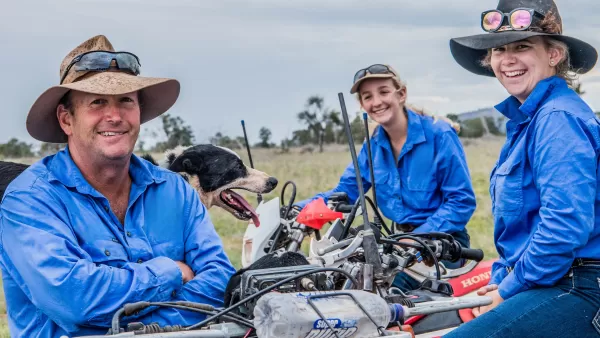Sunshine Coast Dairy Farm
Energy Savings: -1% | Cost Savings: $7,378 | Capital Cost: $30,000 | Project Status: implemented
Industry:
Dairy
Location:
South-East
Pump Type:
Centrifugal
Irrigation Type:
Solid set
Technology:
Irrigation and Pumps, Variable Speed Drives
The site consists of three paddocks irrigated with solid set sprinklers. After talking with the farmer the audit focused on the smaller 4.4ha paddock as the current system is failing to deliver enough water for optimum irrigation. Catch can data from the Distribution Uniformity (DU) test showed 14% and a Coefficient of Uniformity (CU) of 44%, with the target CU being 80%.
The system consists of a 500m 110mm mainline, five two-inch PCV laterals spaced at 32m with 10mmx5mm jet sprinklers, set on 450mm risers at a spacing of 32.5m. A flow rate of 9.3L/s was measured with 42m of head. Energy demand was 9.6kW and an assumed motor efficiency of 80% was used to calculate the pump efficiency of 51%. This results in an overall efficiency rating of 6.83kWh/ML/m which is slightly above the industry benchmark of 5kWh/ML/m and indicates improvements can be made.
The audit recommended replacing and relocate the pump with a new motor and Variable Speed Drive (VSD) to increase pressure delivery while reducing the mainline length and replacing the sprinklers. Two separate pump and sprinkler options were explored, a breakdown of the cost for each system includes:
- Option 7025: Pump motor and VSD $8,000, 25m mainline $4,500 and sprinklers $7,500.
- Option 8025: Larger pump, motor and VSD offers higher pressure and flow $13,000, 25m mainline $6,000 and sprinklers $10,500.
Table 1. Energy and cost savings from audit recommendations
| Recommendation | 7025 Option 18.5kW Motor | 8025 Option 30kW Motor |
| Energy consumption existing mainline shortened and new pump (kWh) | 7,658 | 7,977 |
| Energy consumption new and shortened 150mm PVC mainline and new pump (kWh) | 7,445 | 7,597 |
| Capital cost ($) | 22,000 | 29,500 |
| Cost Savings including productivity gains and increased energy costs ($) | 7,250 | 7,050 |
| Optimum payback period (years) | 3 | 4.2 |
The existing 110mm HDPE pipeline runs 500m to the 1st lateral. At the measured flow rate of 9.3 L/s, this has a friction loss of 7m. The new pump could be relocated reducing the distance to 150m, with a reduction of 5m of friction loss to 2m. The table shows that the farm could save considerably with changes to the irrigation system from either option.
The farmer has proceeded with the installation of the 8025 option. The savings made have been measured in a Measurement and Verification (M&V) process, as outlined in Table 2.
Table 2. Estimated and Actual energy and cost savings.
| Metric | Audit estimation | M&V calculation* | Variation (%) |
| Energy Savings (kWh) | -2,000 | -541 | -73 |
| Cost Savings including productivity gains ($) | 7,050 | 7,378 | 5 |
Due to the higher flow rate in the pump of 17L/s, the run time has been reduced by 127hrs to deliver the same 13.5mL, though uses slightly more energy due to the motors larger size, a total of 4,409kW per year. The energy consumption is still 73% lower than the estimated in the audit.
The production benefit outweighs the cost of increased consumption with an increase in profit. The DU has improved from 14% to 62% and the CU has increased to 78%, almost the expected target. Typical levels of production for dry land farming with low DU are 6-8 tonnes of dry matter per hectare per year (t DM/ha/year). With the improved uniformity and careful management, production is expected to increase over 10-12 t DM/ha/year, this is 18 t DM/year for the 4.4ha, with an estimated value of $7,500.
Also, the pump efficiency has improved from 51% to 54%, better suited to the irrigation system’s design requirements, and has enough pressure and flow for two lines of five sprinklers to be run at a time instead of one line of five. This reduces, almost halves, the labour component required to irrigate and assists with optimising irrigation scheduling and delivery for improved crop growth, yields, health and efficiency, which have not been calculated here.
From the implementation of recommendations in the audit, the farm has increased total energy consumption by 1% and has reduced costs by 41% per year, including productivity gains.
Table 3. Pre and post implementation energy and costs improvements.
| Metric | Pre-implementation | Post-implementation | Reduction (%) |
| Energy Consumption (kWh) | 61,500 | 62,041 | -1 |
| Cost ($) | 18,000 | 10,662 | 41 |
An energy audit is a good investment
An energy audit is a great way for a business to cut costs and boost productivity.
The Energy Savers Plus Extension Program was delivered by the Queensland Farmers' Federation with support and funding from the Queensland Department of Energy and Public Works.

